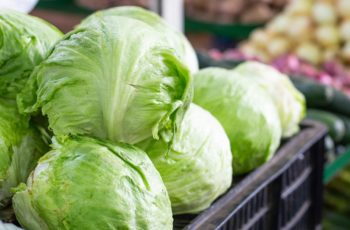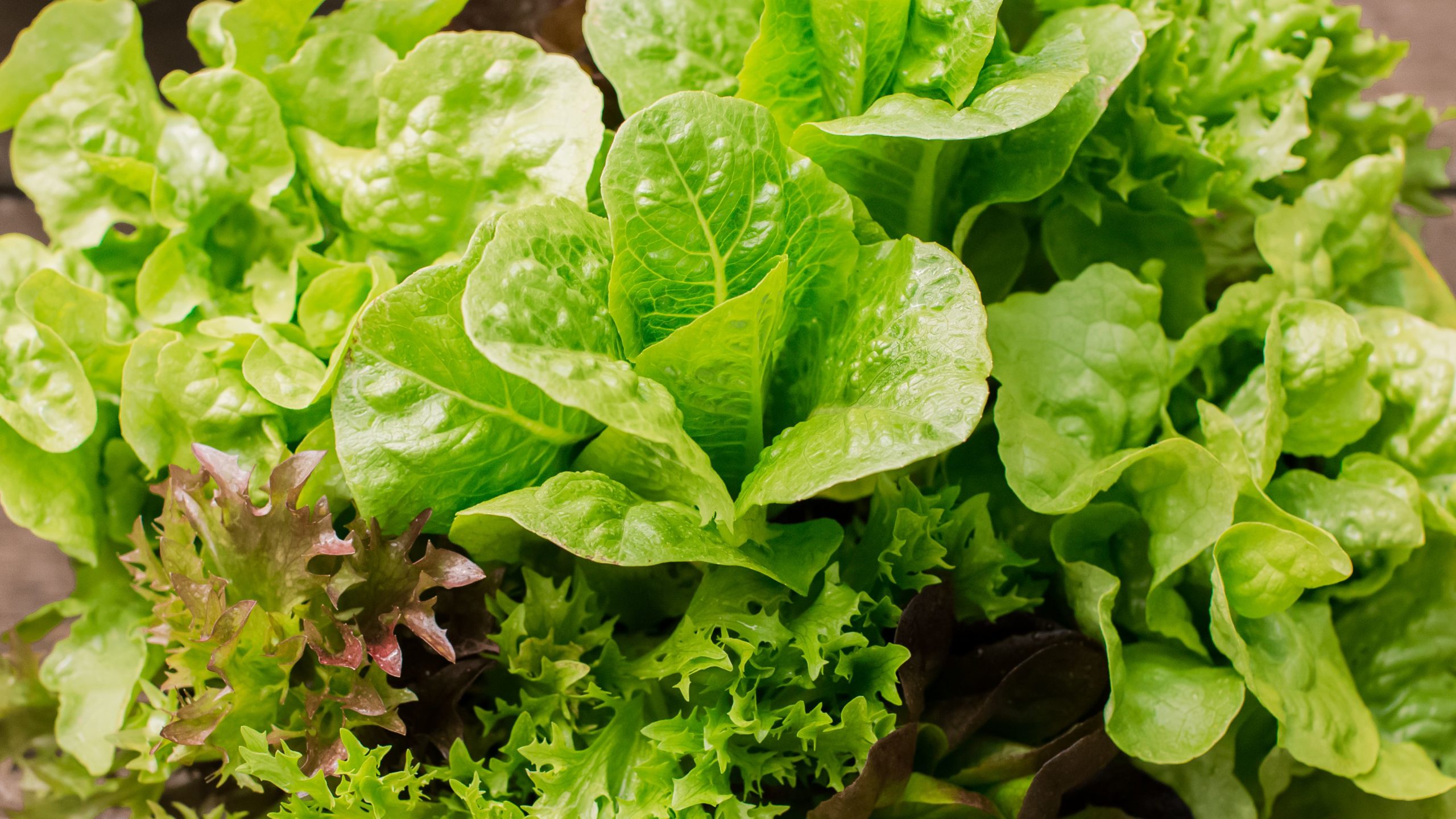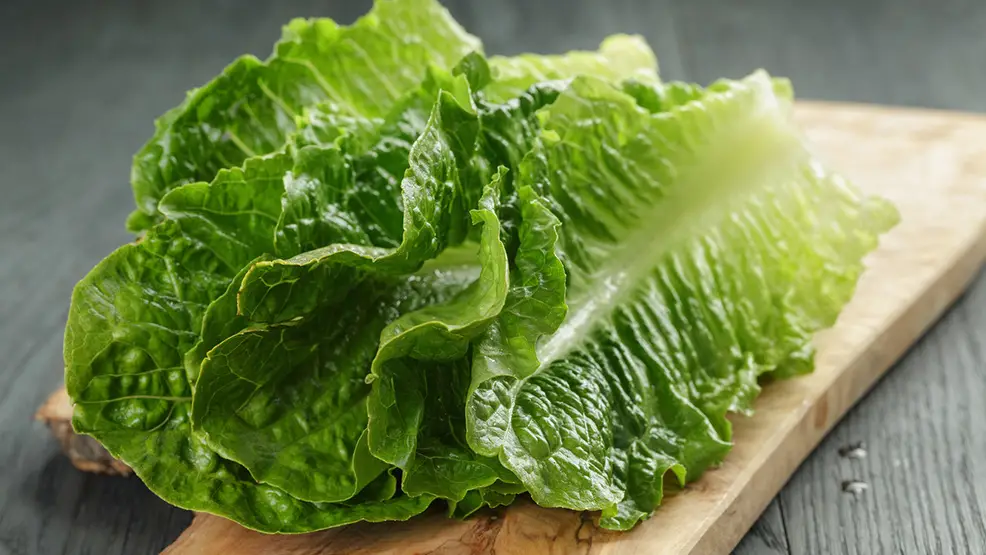
Is lettuce a vegetable? People often debate this question, and there is no clear consensus. Lettuce is commonly used in salads and other dishes, but some people consider it to be a type of fruit. Whether or not you classify lettuce as a vegetable is up to you, but there are certainly some compelling arguments for both positions. Let’s take a closer look at the debate over whether or not lettuce is a vegetable.

What is lettuce?
Lettuce is a plant that belongs to the daisy family. It is most commonly used as a leafy green vegetable or salad ingredient, but there is some debate over whether it should be classified as a vegetable or fruit. Lettuces are typically low in calories and contain vitamins and minerals that are important for human health. There are many different types of lettuce, including iceberg, romaine, butterhead, and leafy greens.
IS LETTUCE A VEGETABLE OR A FRUIT?
Lettuce is a vegetable because it is the edible part of a plant that is used in salads and other dishes. The leaves of the lettuce plant are what we eat, and they contain vitamins and minerals that are important for human health. Lettuces are typically low in calories and contain fiber, which is important for digestion.
Benefits of lettuce:
Lettuce is a low-calorie, nutrient-rich food that offers many health benefits. It is an excellent source of vitamins and minerals, including vitamin A, vitamin C, potassium, and iron. Lettuce also contains antioxidants and phytochemicals that may protect against chronic diseases such as cancer and heart disease. Additionally, lettuce is a good source of fiber, which is important for digestive health. Including lettuce in your diet can help you meet your daily recommended intake of vegetables and may promote overall health and well-being.
Along with its many nutritional benefits, lettuce also offers other important health benefits. For example, it may help to control blood sugar levels and improve digestive function. Additionally, studies have shown that lettuce may help to lower cholesterol levels and reduce inflammation in the body. Overall, incorporating more lettuce into your diet can be an easy and effective way to boost your overall health and well-being.

IS LETTUCE A CRUCIFEROUS VEGETABLE?
Lettuce is not a cruciferous vegetable. Cruciferous vegetables are plants in the mustard family that includes cabbage, kale, and broccoli. These vegetables are known for their nutritional benefits, including their high vitamin and mineral content. While lettuce does belong to the daisy family, it is not related to mustard plants. Therefore, it does not share the same nutritional properties as cruciferous vegetables.
What Kind of Vegetable is Lettuce?
While there is some debate over whether lettuce should be classified as a vegetable or fruit, most people agree that it is a vegetable. This is because lettuce is typically used in salads and other dishes, and because it comes from a plant. Lettuce is a low-calorie, nutrient-rich food that offers many health benefits. It is an excellent source of vitamins and minerals, including vitamin A, vitamin C, potassium, and iron. Lettuce also contains antioxidants and phytochemicals that may protect against chronic diseases such as cancer and heart disease. Including lettuce in your diet can help you meet your daily recommended intake of vegetables and may promote overall health and well-being.

Is Lettuce Good For You?
Yes, lettuce is good for you! Lettuce is a low-calorie, nutrient-rich food that offers many health benefits. It is an excellent source of vitamins and minerals, including vitamin A, vitamin C, potassium, and iron. Lettuce also contains antioxidants and phytochemicals that may protect against chronic diseases such as cancer and heart disease. Additionally, lettuce is a good source of fiber, which is important for digestive health. Including lettuce in your diet can help you meet your daily recommended intake of vegetables and may promote overall health and well-being.
Types of lettuce:
There are many different types of lettuce, including iceberg, romaine, leaf, and butterhead. Each type of lettuce has its own unique flavor and texture. Iceberg lettuce is the most common type of lettuce in the United States. It has a crisp texture and mild flavor. Romaine lettuce is a type of lettuce that is often used in Caesar salads. It has a slightly bitter taste and a firm texture. Leaf lettuce is a type of lettuce that has large, soft leaves. It has a mild flavor and is often used in salads. Butterhead lettuce is a type of lettuce that has a buttery texture and a sweet flavor. It is often used in sandwiches and wraps.
How to select and store:
When selecting lettuce, look for leaves that are crisp and free of brown spots. Avoid lettuce that is wilted or has yellowed leaves. Lettuce can be stored in the refrigerator for up to one week. Wrap the lettuce in a paper towel or place it in a container with holes to allow air to circulate. This will help to keep the lettuce from becoming wilted.
Is Lettuce a Man-Made Plant?
No, lettuce is not a man-made plant. Lettuce is a low-calorie, nutrient-rich food that offers many health benefits. It is an excellent source of vitamins and minerals, including vitamin A, vitamin C, potassium, and iron. Lettuce also contains antioxidants and phytochemicals that may protect against chronic diseases such as cancer and heart disease. Including lettuce in your diet can help you meet your daily recommended intake of vegetables and may promote overall health and well-being.
Things to Watch Out For when eating lettuce:
While lettuce is generally considered to be healthy food, there are some important things to watch out for when eating it. For example, if you buy pre-packaged lettuce that has been washed and pre-cut, you will need to take extra care to ensure that the greens do not become contaminated with bacteria or other pathogens. This can happen easily in environments where food safety is not a priority, such as in restaurant kitchens or at home if good hygiene practices are not followed. Additionally, some types of lettuce may contain natural toxins like lactucarium or oxalic acid that can be harmful when consumed in large quantities.
Another potential issue with eating lettuce is its relatively high water content. Since lettuce is mostly made up of water, it can be easy to overeat and end up consuming a lot of unnecessary calories. Additionally, this high water content may cause some lettuce varieties to wilt or go bad more quickly than other leafy green vegetables. So if you are trying to lose weight or simply want to keep your lettuce fresh for as long as possible, be sure to monitor portion sizes and store your greens properly.
Overall, while eating lettuce is generally considered safe, there are some important things to watch out for in order to ensure that you get all the benefits of this nutritious vegetable without any negative side effects. By following good food safety practices and paying attention to portion sizes, you can enjoy the many health benefits of lettuce without putting yourself at risk!
How to Prepare Lettuce:
There are many different ways to prepare lettuce, so it can be easily incorporated into any diet. For example, lettuce can be eaten raw in salads or sandwiches, cooked in soups or stir-fries, or used as a wrap or tortilla alternative. Additionally, there are many different types of lettuce available, so you can experiment with different flavors and textures to find what you like best. Some popular varieties include iceberg, romaine, butterhead, and leaf lettuce.
When selecting lettuce for your meals, look for greens that are crisp and free from browning or wilting. Avoid pre-cut or washed greens if possible, as these may be more likely to harbor bacteria. If you do buy pre-packaged lettuce, be sure to store it properly and use it as soon as possible to minimize the risk of bacterial contamination.
To prepare lettuce for cooking, start by washing your greens thoroughly in cold water. Then, pat dry with paper towels or a clean kitchen towel before using. Depending on the recipe you are preparing, you may also want to remove any leaves that are wilted or bruised, or chop your greens into desired size and shape. After prepping your lettuce, you can then cook your greens according to your preferred method (sautéing, roasting, steaming), add them to soups or stews, or incorporate them into salads or sandwiches! With so many delicious options for preparing lettuce, there is no shortage of ways to enjoy this healthy vegetable.
Why is Lettuce a Vegetable?
Lettuce is classified as a vegetable because it is mostly composed of water and contains very few calories. Additionally, lettuce is a good source of vitamins and minerals like vitamin A, potassium, and iron. While it is true that lettuce does not have as many nutrients as some other vegetables, it can still be a healthy part of your diet when eaten in moderation.
So there you have it – everything you need to know about lettuce! This versatile vegetable can be easily incorporated into any diet, and with so many different ways to prepare it, there is sure to be a recipe out there that you will love. So go ahead and start adding more lettuce to your meals – your body will thank you for the extra boost of nutrients!
Why Adding Lettuce To Your Diet is Important
As we mentioned before, lettuce is a good source of vitamins and minerals like vitamin A, potassium, and iron. Additionally, lettuce is low in calories and fat, making it a great choice for those who are trying to lose weight or maintain a healthy weight. Additionally, the high water content in lettuce can help you stay hydrated, and the fiber content may help to promote regularity.
What’s the Best Lettuce One Can Eat?
There are many different types of lettuce available, so it really depends on your personal preferences. Some popular varieties include iceberg, romaine, butterhead, and leaf lettuce. Ultimately, the best lettuce for you is the one that you will enjoy eating the most!
How Much Lettuce Should You Eat Per Day?
There is no set recommendation for how much lettuce you should eat per day, but including a few servings of this healthy vegetable in your diet is a good way to make sure you are getting all the nutrients you need. Try incorporating lettuce into salads, sandwiches, soups, or stir-fries, or simply eating it raw as a snack. As with any food, moderation is key – too much of anything can be unhealthy. So be sure to listen to your body and stop eating if you start to feel full or uncomfortable.
How to Eat More Lettuce
There are many different ways to add lettuce to your diets, such as incorporating it into salads and sandwiches or cooking it in soups, stews, and stir-fries. Here are some tips for how to eat more lettuce:
- Start by adding small amounts of lettuce to your favorite meals. For example, you can try swapping out half of the lettuce in your salad for some baby spinach or kale leaves.
- Experiment with different kinds of lettuce and different preparation methods, such as roasting or sautéing greens instead of eating them raw. You may find that you enjoy certain types or preparations more than others.
- Incorporate leafy greens into smoothies and juices so that you can still enjoy the health benefits of lettuce while getting a boost of other nutrients.
- Try adding chopped or shredded lettuce to wraps, tacos, and burrito bowls for an easy way to add more greens to your diet.
- Consider growing your own lettuce at home so that you always have a fresh supply on hand. This is also a great way to get kids involved in healthy eating!
FAQs
Does Lettuce Need to be Refrigerated?
Yes, lettuce should be kept in the refrigerator in order to stay fresh. Lettuce can be stored in a plastic bag or container with a lid for up to a week.
Is Lettuce Good for You?
Yes, lettuce is a healthy vegetable that is low in calories and fat and high in vitamins, minerals, and water. Including lettuce in your diet can help you stay hydrated and promote regularity.
How Many Calories are in Lettuce?
There are only about 5 calories in a cup of chopped lettuce. This makes it a great choice for those who are trying to lose weight or maintain a healthy weight. Additionally, the high water content in lettuce can help you stay hydrated and feel full.
How Can I Make Lettuce More Flavorful?
There are many different ways to add flavor to lettuce, such as using dressings, marinades, and seasonings like lemon juice, olive oil, garlic, salt, pepper, hot sauce, or fresh herbs. You can also try incorporating other delicious ingredients into your salads and wraps such as avocado, nuts and seeds, hard-boiled eggs, roasted vegetables or meat/seafood. Experimenting with different combinations of flavors is the best way to find the ones that you enjoy most!
Can Lettuce be Eaten Eaw?
Yes, it is perfectly safe and healthy to eat lettuce raw. In fact, many people prefer the taste of raw lettuce and enjoy eating it as a snack or adding it to smoothies, juices, and salads. Just be sure to choose high-quality, fresh lettuce that has not been washed with harmful chemicals like chlorine. Additionally, you may want to avoid eating iceberg lettuce or other varieties that are low in nutrients or high in pesticides. Overall, there are many ways to enjoy the delicious flavor and nutritional benefits of lettuce – no matter how you choose to eat it!
What Is The Difference Between Iceberg And Romaine?
There are many different types and varieties of lettuce, each with its own unique characteristics and nutritional content. For example, compared to iceberg lettuce, romaine is generally higher in vitamins and minerals like potassium, calcium, iron, magnesium, folate, vitamins A, C, E, and K. It also contains more antioxidants that can help protect against chronic diseases like heart disease and cancer. Overall, the best way to choose between different types of lettuce is by considering your personal preferences as well as nutrient needs based on health goals or dietary restrictions. Whether you prefer romaine or another type of lettuce such as butterhead or arugula, there are many delicious ways to enjoy this healthy vegetable!
Are Lettuce Leaves Good For You?
Yes, lettuce leaves are an excellent source of many nutrients. They are high in vitamins A, C, and K and dietary fiber, as well as folate, magnesium, iron, calcium, potassium, and antioxidants. Eating lettuce regularly can help promote digestive health and support the immune system. Additionally, incorporating more leafy greens into your diet is associated with a lower risk of certain chronic diseases like heart disease and cancer. Overall, there are many benefits to eating lettuce leaves both raw and cooked – so be sure to include this healthy vegetable in your diet on a regular basis!
Is Lettuce Worth Growing At Home?
There are many different factors that can influence whether or not lettuce is worth growing at home, including your experience and skill level as a gardener, the type of environment you live in, and your desired yield. For example, if you have previous gardening experience and live in a temperate climate with adequate sunlight and water resources, then it may be feasible to grow lettuce successfully at home. However, if you are new to gardening or live in a more challenging environment like a desert or high-altitude region with limited access to water, then it may be best to purchase fresh lettuce from the grocery store or farmer’s market instead. Ultimately, whether or not lettuce is worth growing depends on the individual circumstances of each gardener – so it is important to consider your specific situation and make a decision based on what feels most comfortable and feasible for you.
How To Grow Lettuce At Home
If you have decided that growing lettuce at home is right for you, then there are a few things you will need to do in order to be successful. First, choose a type of lettuce that is well-suited to your climate and gardening conditions. Second, prepare your garden bed by making sure it is free of weeds and has good drainage. Third, plant your seeds or seedlings in early spring after the last frost date. Finally, water regularly and harvest when the leaves are big enough to eat. By following these simple steps, you can enjoy fresh, homegrown lettuce all season long!
Is iceberg lettuce a cruciferous vegetable?
No, iceberg lettuce is not a cruciferous vegetable. Cruciferous vegetables are plants in the Brassica family that includes broccoli, cabbage, cauliflower, and Brussels sprouts. These vegetables are known for their high nutrient content, including vitamins, minerals, fiber, and antioxidants. While iceberg lettuce does contain some nutrients, it is not as high in nutrients as other types of lettuce or other cruciferous vegetables. Therefore, it is not considered to be a cruciferous vegetable.
Is lettuce a starchy vegetable?
No, lettuce is not considered to be a starchy vegetable. While some types of lettuce do contain some carbohydrates and fiber, they are typically lower in these nutrients than other starchy vegetables like potatoes, corn, and legumes. This is partly because lettuce plants store their energy in leaves instead of roots or tubers like other vegetables. Additionally, the texture of lettuce can range from crisp and crunchy to tender and juicy depending on the variety – which may contribute further to its lack of starchiness. Overall, while lettuce does contain some carbohydrates and fiber, it is generally considered to be a non-starchy vegetable that is low in calories and high in other important nutrients like vitamins A and C.
Learn More About Grilling
If you want to learn more about grilling, check out these other helpful resources!











